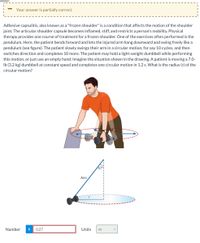Question

Transcribed Image Text:Your answer is partially correct.
Adhesive capsulitis, also known as a "frozen shoulder" is a condition that affects the motion of the shoulder
joint. The articular shoulder capsule becomes inflamed, stiff, and restricts a person's mobility. Physical
therapy provides one course of treatment for a frozen shoulder. One of the exercises often performed is the
pendulum. Here, the patient bends forward and lets the injured arm hang downward and swing freely like a
pendulum (see figure). The patient slowly swings their arm in a circular motion, for say 10 cycles, and then
switches direction and completes 10 more. The patient may hold a light-weight dumbbell while performing
this motion, or just use an empty hand. Imagine the situation shown in the drawing. A patient is moving a 7.0-
Ib (3.2 kg) dumbbell at constant speed and completes one circular motion in 1.2 s. What is the radius (r) of the
circular motion?
47°1
Arm
Number
i
0.27
Units
m
Expert Solution
arrow_forward
Step 1
Trending nowThis is a popular solution!
Step by stepSolved in 3 steps with 1 images

Knowledge Booster
Similar questions
- A cube, whose mass is 0.700 kg, is attached to a spring with a force constant of 110 N/m. The cube rests upon a frictionless, horizontal surface (shown in the figure below). A cube labeled m is attached to the right end of a horizontal spring, and the left end of the spring is attached to a wall. The spring is stretched horizontally such that the cube is displaced by a distance A to the right of its equilibrium position. The cube is pulled to the right a distance A = 0.110 m from its equilibrium position (the vertical dashed line) and held motionless. The cube is then released from rest. (a) At the instant of release, what is the magnitude of the spring force (in N) acting upon the cube? N (b) At that very instant, what is the magnitude of the cube's acceleration (in m/s2)? m/s2 (c) In what direction does the acceleration vector point at the instant of release?arrow_forwardA small ball is attached to one end of a spring that has an unstrained length of 0.185 m. The spring is held by the other end, and the ball is whirled around in a horizontal circle at a speed of 4.80 m/s. The spring remains nearly parallel to the ground during the motion and is observed to stretch by 0.0190 m. By how much would the spring stretch if it were attached to the ceiling and the ball allowed to hang straight down, motionless? Number Unitsarrow_forwardStudents work together during an experiment about Newton’s laws. The students use a setup that consists of a cart of known mass connected to one end of a string that is looped over a pulley of negligible friction, with its other end connected to a hanging mass. The cart is initially at rest on a horizontal surface and rolls without slipping when released. The inertia of the cart's wheels is negligible. Students have access to common laboratory equipment to make measurements of components of the system. By collecting the appropriate data, the students can determine the relationship between the acceleration of the cart and the net force exerted on the cart. Which of the following graphs should the students produce to show the correct relationship? a A b C c D d Barrow_forward
- A large solid disk with radius rb= 1.1m has a second, smaller solid disk with radius rs= 0.32m and mass ms= 3.5kg attached to it. Wrapped around the smaller disk is an ideal string with a hanging mass mh= 2.3kg attached to it. The hanging mass starts out a distance yi= 5.2m above the ground as shown in Figure 1, and falls towards the ground with constant speed. a) What is the torque about the center of the pulleys? Remember torque is a vector. b) What should the mass of the larger pulley be such that the system of pulleys has an angular acceleration of α = 1.2rad/s ? c) How long will it take the hanging mass to hit the ground?arrow_forwardIn the figure, a motor weighing 3000 N hangs on a chain attached by an O-ring to two other chains, one attached to the ceiling and the other to the wall. Calculate the tensile force acting on the chain attached to the wall. Consider that the weights of the chains and the ring are negligible.arrow_forwardA1 kg mass is tied to a string and is being swung in a horizontal circle. The mass has a constant angular velocity of 0.3 rad/s. The string has a Young's modulus of 10 X 106 N/m?, and the string's original length is 0.7 m long. The radius of the string is 0.05 cm. How much does the string stretch? You can think of the string as being shaped like a long, thin cylinder. 5.6 mm 2.7 mm 3.2 mm 4.7 mm 3.8 mmarrow_forward
arrow_back_ios
arrow_forward_ios